Amorphous InGaZnO Thin-Film Transistors with Double-Stacked Channel Layers for Ultraviolet Light Detection
Abstract
1. Introduction
2. Materials and Methods
3. Results and Discussion
4. Conclusions
Author Contributions
Funding
Data Availability Statement
Acknowledgments
Conflicts of Interest
References
- Zhou, H.; Li, L.; Chen, H.; Guo, Z.; Jiao, S.; Sun, W. Realization of a fast-response flexible ultraviolet photodetector employing a metal-semiconductor-metal structure InGaZnO photodiode. R. Soc. Chem. Adv. 2015, 5, 87993–87997. [Google Scholar] [CrossRef]
- Park, J.; Lee, H. Improvement of the Performance and Stability of Oxide Semiconductor Thin-Film Transistors Using Double-Stacked Active Layers. IEEE Electron Device Lett. 2012, 33, 818–820. [Google Scholar] [CrossRef]
- Ferhati, H.; Djeffal, F. Giant responsivity of a new InGaZnO Ultraviolet thin-film phototransistor based on combined dual gate engineering and surface decorated Ag nanoparticles aspects. Sens. Actuators A Phys. 2020, 318, 112523. [Google Scholar] [CrossRef]
- Singh, A.; Chourasia, N.; Pal, B.; Pandey, A.; Chakrabarti, P. A Proposed All ZnO Based Thin Film Transistor For UV-B Detection. IEEE Photonics Technol. Lett. 2020, 32, 1548–1551. [Google Scholar] [CrossRef]
- Nomura, K.; Ohta, H.; Takagi, A.; Kamiya, T.; Hirano, M.; Hosono, H. Room-temperature fabrication of transparent flexible thin-film transistors using amorphous oxide semiconductors. Nature 2004, 432, 488–492. [Google Scholar] [CrossRef]
- Kamiya, T.; Nomura, K.; Hosono, H. Present status of amorphous In-Ga-Zn-O thin-film transistors. Sci. Technol. Adv. Mater. 2010, 11, 044305. [Google Scholar] [CrossRef] [PubMed]
- Jeong, J.; Jeong, J.; Choi, J.; Im, J.; Kim, S.; Yang, H.; Kang, K.; Kim, K.; Ahn, T.; Chung, H.; et al. 3.1: Distinguished Paper: 12.1-Inch WXGA AMOLED display driven by indium-gallium-zinc oxide TFTs array. SID Symp. Dig. Tech. Pap. 2008, 39, 1–4. [Google Scholar] [CrossRef]
- Yabuta, H.; Sano, M.; Abe, K.; Aiba, T.; Den, T.; Kumomi, H.; Nomura, K.; Kamiya, T.; Hosono, H. High-mobility thin-film transistor with amorphous InGaZnO4 channel fabricated by room temperature rf-magnetron sputtering. Appl. Phys. Lett. 2006, 89, 112123. [Google Scholar] [CrossRef]
- Chen, Y.; Chang, T.; Li, H.; Hsieh, T.; Chen, T.; Wu, C.; Chou, C.; Chung, W.; Chang, J.; Tai, Y. The suppressed negative bias illumination-induced instability in In-Ga-Zn-O thin film transistors with fringe field structure. Appl. Phys. Lett. 2012, 101, 223502. [Google Scholar] [CrossRef]
- Choi, S.; Kim, J.; Kang, H.; Ko, D.; Rhee, J.; Choi, S.J.; Kim, D.M.; Kim, D.H. Effect of Oxygen Content on Current Stress-Induced Instability in Bottom-Gate Amorphous InGaZnO Thin-Film Transistors. Materials 2019, 12, 3149–3159. [Google Scholar] [CrossRef]
- Lu, H.; Zhou, X.; Liang, T.; Zhang, L.; Zhang, S. Oxide TFTs with IMO and IGZO stacked active layers for UV detection. J. Electron Devices Soc. 2017, 5, 504–508. [Google Scholar] [CrossRef]
- Yu, J.; Javaid, K.; Liang, L.; Wu, W.; Liang, Y.; Song, A.; Zhang, H.; Shi, W.; Chang, T.; Cao, H. High-Performance visible-blind ultraviolet photodetector based on IGZO TFT coupled with p−n heterojunction. ACS Appl. Mater. Interfaces 2018, 10, 8102–8109. [Google Scholar] [CrossRef] [PubMed]
- Tak, Y.; Kim, D.; Kim, W.; Lee, J.; Kim, S.; Kim, J.; Kim, H. Boosting visible light absorption of metal-oxide-Based phototransistors via heterogeneous in-Ga-Zn-O and CH3NH3PbI3 films. ACS Appl. Mater. Interfaces 2018, 10, 12854–12861. [Google Scholar] [CrossRef]
- Chen, K.; Hsu, C.; Yu, H.; Peng, Y.; Yang, C.; Su, Y. The effect of oxygen vacancy concentration on Indium Gallium Oxide solar blind photodetector. IEEE Trans. Electron Devises 2018, 65, 1817–1822. [Google Scholar] [CrossRef]
- Jang, J.; Ko, D.; Choi, S.; Kang, H.; Kim, J.; Yu, H.; Ahn, G.; Jung, H.; Rhee, J.; Lee, H.; et al. Effects of structure and oxygen flow rate on the photo-response of amorphous IGZO-based photodetector devices. Solid State Electron. 2018, 140, 115–121. [Google Scholar] [CrossRef]
- Wang, X.; Shao, Y.; Wu, X.; Zhang, M.; Li, L.; Liu, W.; Zhang, D.; Ding, S. Light response behaviors of amorphous In-Ga-Zn-O thin-film transistors via in situ interfacial hydrogen doping modulation. RSC Adv. 2020, 10, 3572. [Google Scholar] [CrossRef] [PubMed]
- Chen, X.; He, G.; Liu, M.; Zhang, J.; Deng, B.; Wang, P.; Zhang, M.; Lv, J.; Sun, Z. Modulation of optical and electrical properties of sputtering-derived amorphous InGaZnO thin films by oxygen partial pressure. J. Alloys Compd. 2014, 615, 636–642. [Google Scholar] [CrossRef]
- Fan, Z.; Zhang, W.; Shen, A.; Dong, C. Ultraviolet Light Response of Amorphous Oxide Thin-Film Transistors with Double-Stacked Channel Layers. SID Symp. Dig. Tech. Pap. 2022, 53, 621–624. [Google Scholar] [CrossRef]
- Xie, H.; Wu, Q.; Xu, L.; Zhang, L.; Liu, G.; Dong, C. Nitrogen-doped amorphous oxide semiconductor thin film transistors with double-stacked channel layers. Appl. Surf. Sci. 2016, 387, 237–243. [Google Scholar] [CrossRef]
- Victory Device User’s Manual, Silvaco TCAD. 2019. Available online: https://www.silvaco.com/tcad.html (accessed on 2 November 2022).
- Xiao, X.; Deng, W.; Chi, S.; Shao, Y.; He, X.; Wang, L.; Zhang, S. Effect of O2 Flow Rate During Channel Layer Deposition on Negative Gate Bias Stress-Induced Vth Shift of a-IGZO TFTs. IEEE Trans. Electron Devices 2013, 60, 4159–4164. [Google Scholar] [CrossRef]
- Mativenga, M.; Haque, F.; Billah, M.; Um, J. Origin of light instability in amorphous IGZO thin-film transistors and its suppression. Sci. Rep. 2021, 11, 14618. [Google Scholar] [CrossRef] [PubMed]
- Xie, H.; Xu, J.; Liu, G.; Zhang, L.; Dong, C. Development and analysis of nitrogen-doped amorphous InGaZnO thin film transistors. Mater. Sci. Semicond. Process. 2017, 64, 1–5. [Google Scholar] [CrossRef]
- Zhang, W.; Fan, Z.; Shen, A.; Dong, C. Atmosphere Effect in Post-Annealing Treatments for Amorphous InGaZnO Thin-Film Transistors with SiOx Passivation Layers. Micromachines 2021, 12, 1551. [Google Scholar] [CrossRef] [PubMed]
- Cochran, E.; Park, D.; Kast, M.; Enman, L.; Perkins, C.; Mansergh, R.; Keszler, D.; Johnson, D.; Boettcher, S. Role of Combustion Chemistry in Low-Temperature Deposition of Metal Oxide Thin Films from Solution. Chem. Mater. 2017, 29, 9480–9488. [Google Scholar] [CrossRef]
- Sen, A.; Park, H.; Pujar, P.; Bala, A.; Cho, H.; Liu, N.; Gandla, S.; Kim, S. Probing the Efficacy of Large-Scale Nonporous IGZO for Visible-to-NIR Detection Capability: An Approach toward High-Performance Image Sensor Circuitry. ACS Nano 2022, 16, 9267–9277. [Google Scholar] [CrossRef]
- Ryu, B.; Noh, H.; Choi, E.; Chang, K. O-vacancy as the origin of negative bias illumination stress. Appl. Phys. Lett. 2010, 97, 022108. [Google Scholar] [CrossRef]
- Yang, G.; Park, J.; Choi, S.; Kim, C.; Kim, D.; Choi, S.-J.; Bae, J.-H.; Cho, I.; Kim, D.H. Total Subgap Range Density of States-Based Analysis of the Effect of Oxygen Flow Rate on the Bias Stress Instabilities in a-IGZO TFTs. IEEE Trans. Electron Devices 2022, 69, 166–173. [Google Scholar] [CrossRef]
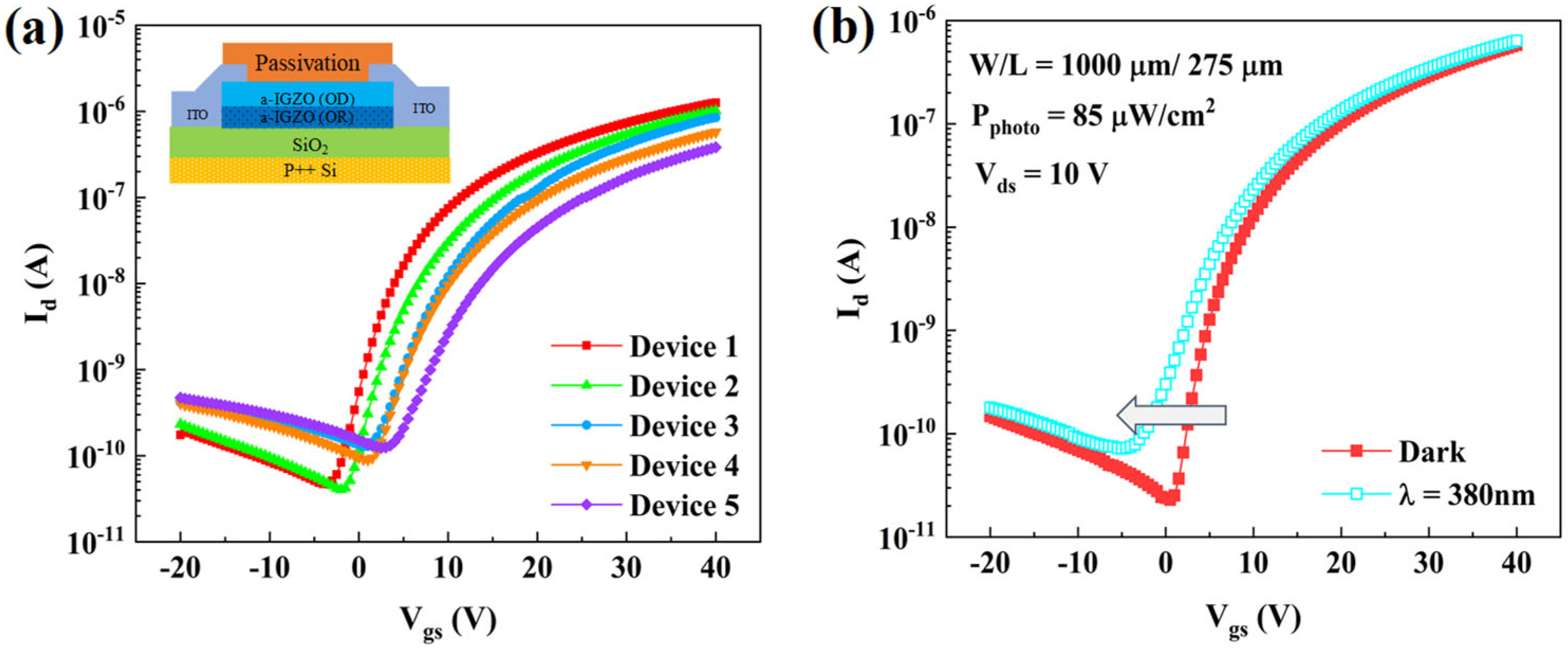
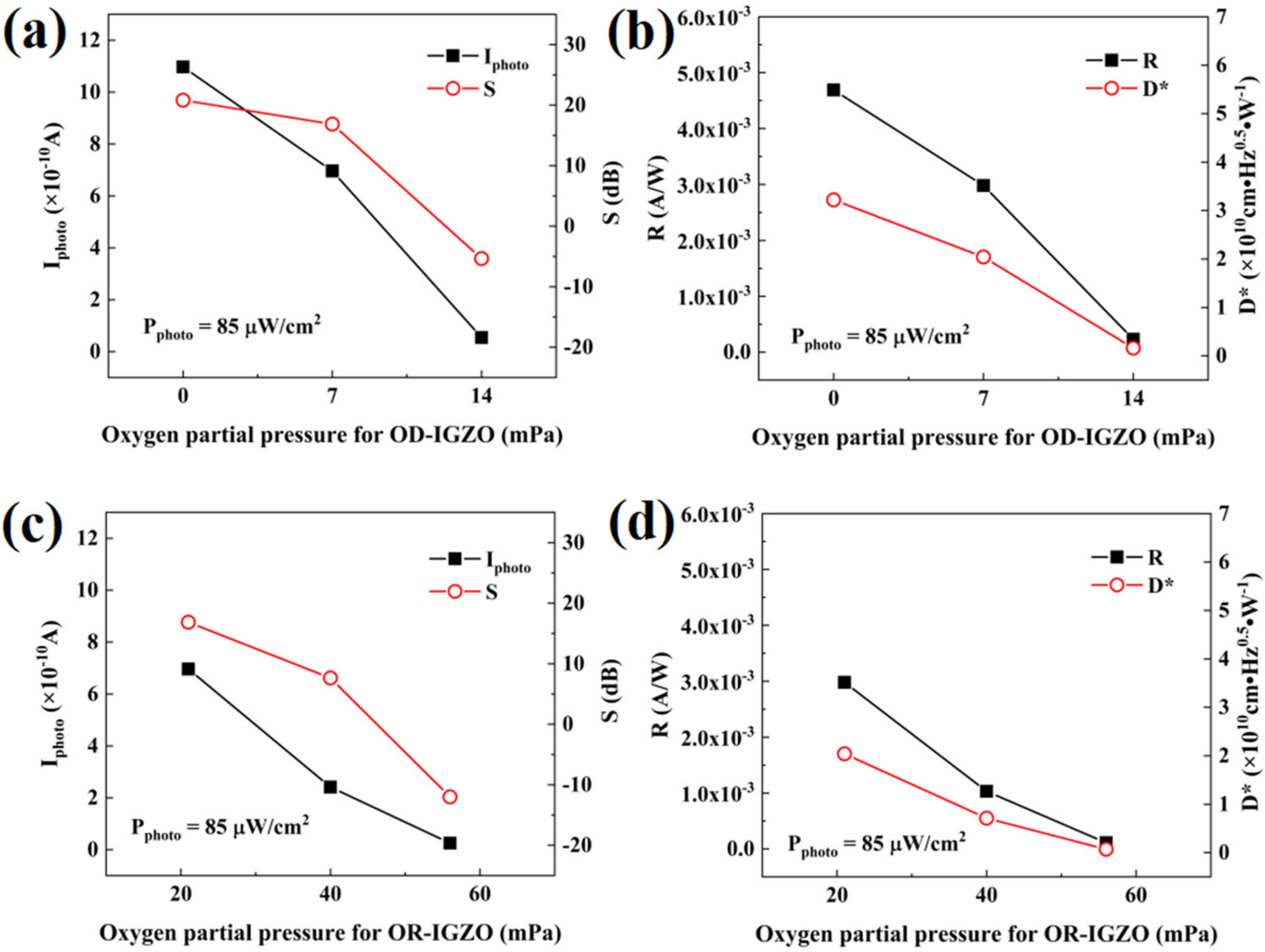
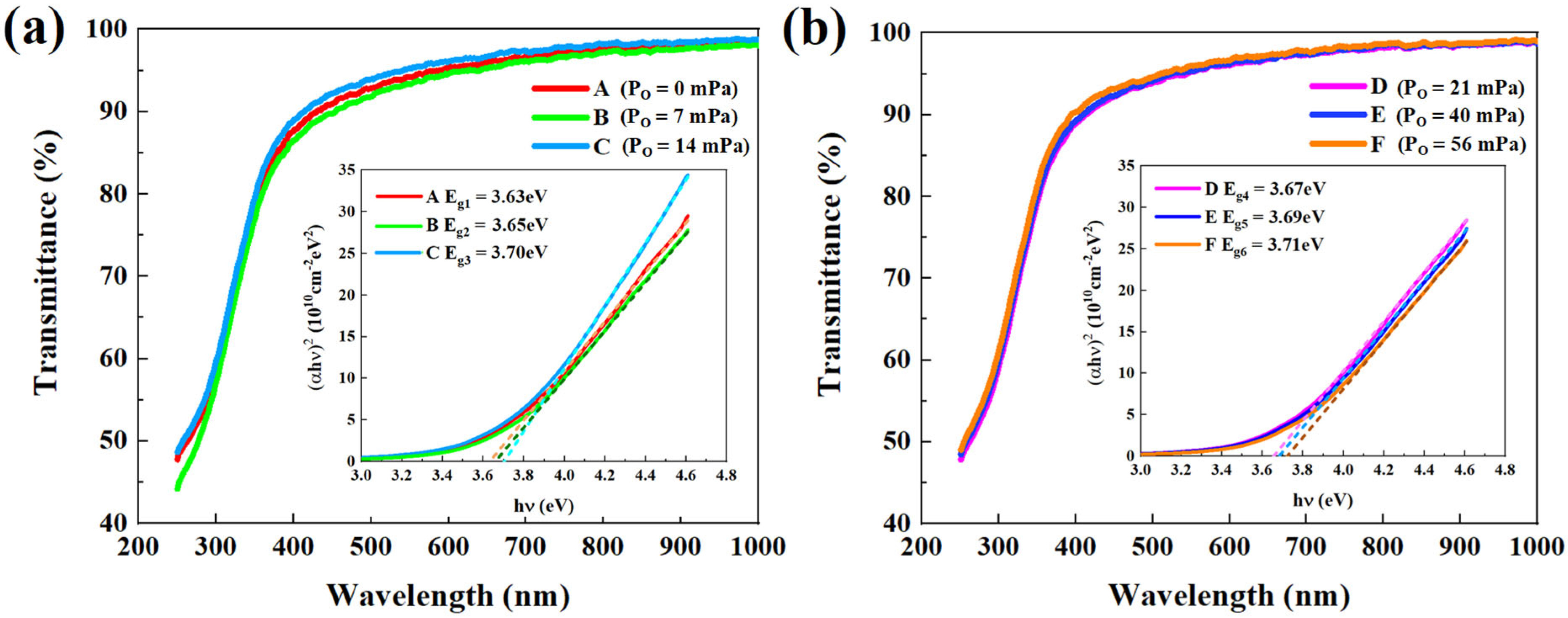
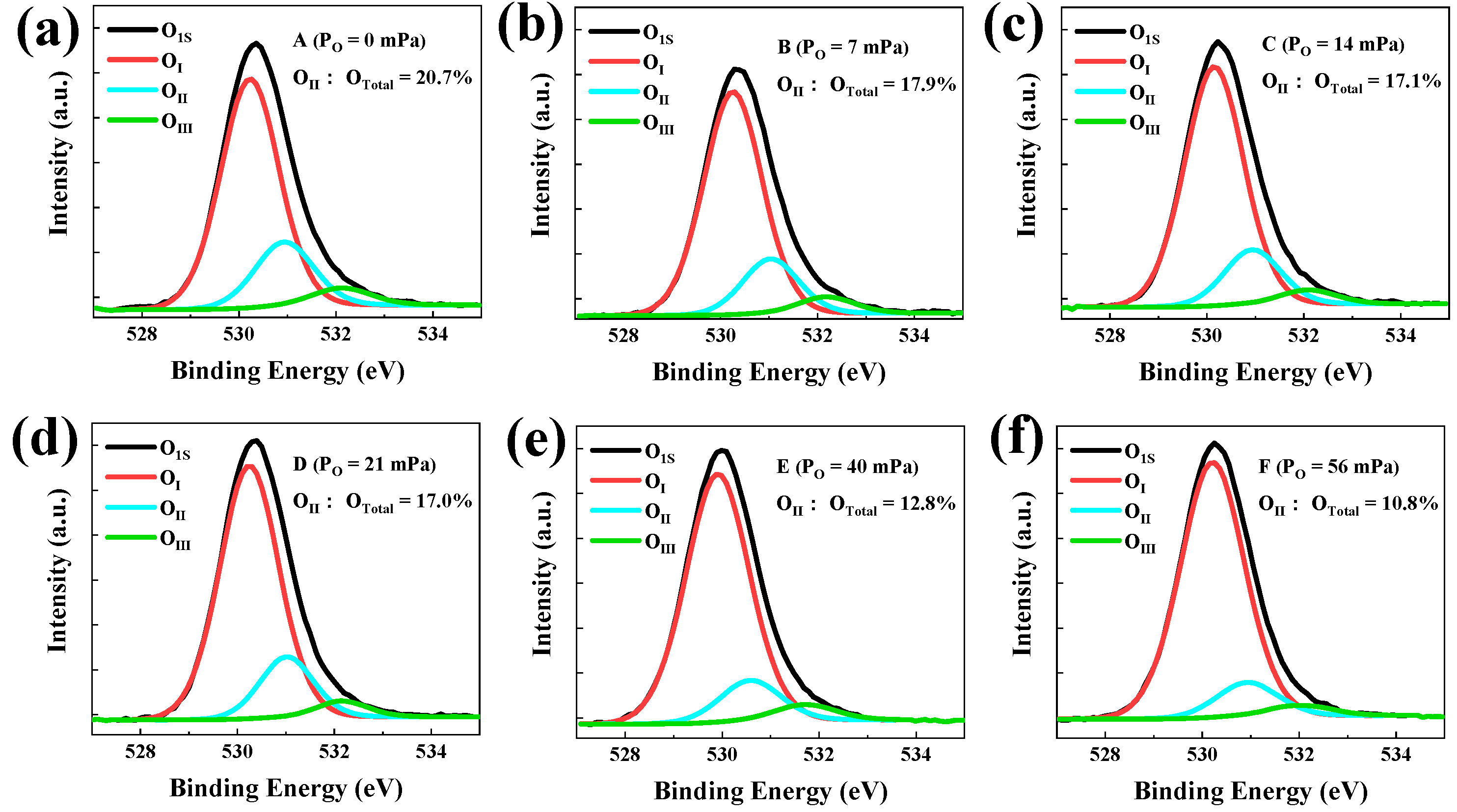
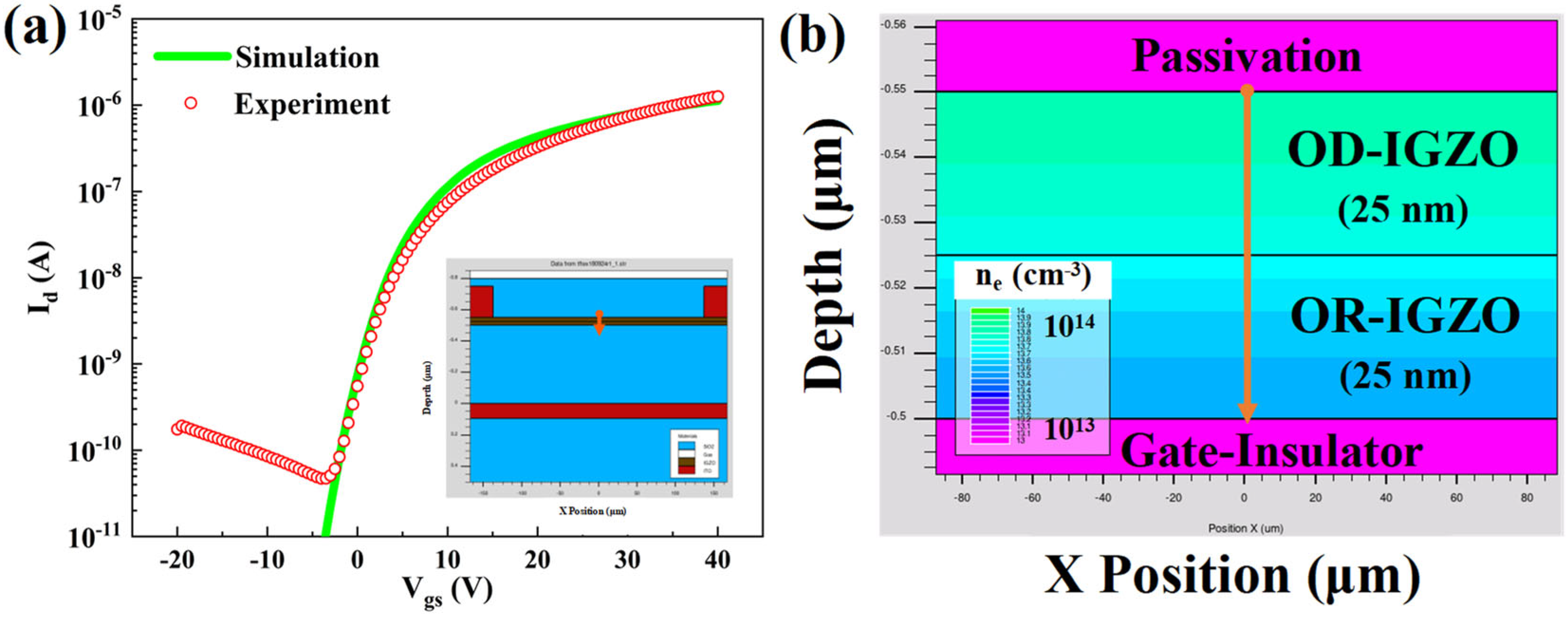
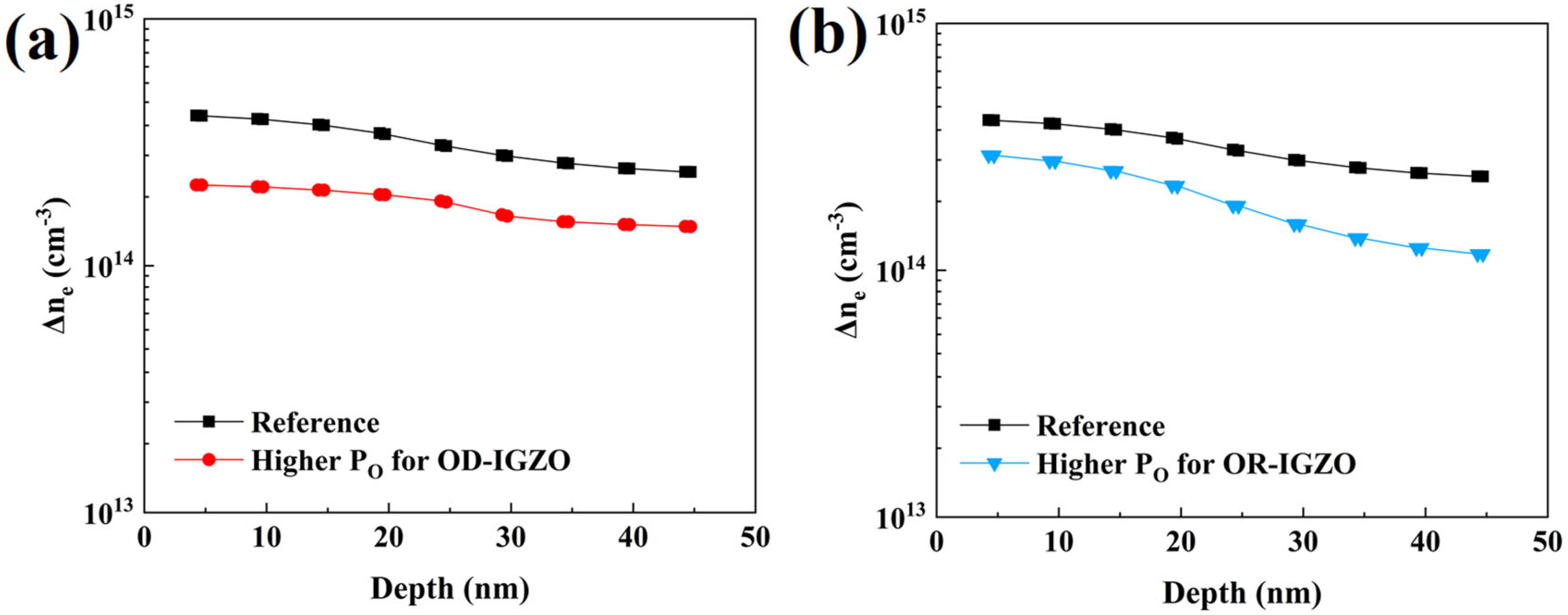
| Device 1 | Device 2 | Device 3 | Device 4 | Device 5 | |
|---|---|---|---|---|---|
| OD-IGZO | 0 | 7 | 14 | 7 | 7 |
| OR-IGZO | 21 | 21 | 21 | 40 | 56 |
| PO Variation Layer | ΔIphoto/ΔPO (A·mPa−1) | ΔS/ΔPO (dB·mPa−1) | ΔR/ΔPO (A·W−1·mPa−1) | ΔD*/ΔPO (Jones·mPa−1) |
|---|---|---|---|---|
| OD-IGZO | −7.5 × 10−11 | −1.9 | −3.2 × 10−4 | −2.2 × 109 |
| OR-IGZO | −1.9 × 10−11 | −0.8 | −8.2 × 10−5 | −5.6 × 108 |
| Parameter. | OD-IGZO | OR-IGZO | Description |
|---|---|---|---|
| NC300 (cm−3) | 5.0×1019 | 5.0×1019 | The conduction band equivalent density at 300 K. |
| NV300 (cm−3) | 1.55×1020 | 1.55×1020 | The valence band equivalent density at 300 K. |
| EG300 (eV) | 3.65 | 3.65 | The energy gap at 300 K. |
| Affinity (eV) | 4.16 | 4.16 | The electron affinity. |
| NTD (cm−3eV−1) | 3.0×1021 | 3.0×1021 | The donor-like trap density per unit energy at the valence band edge. |
| NTA (cm−3eV−1) | 5.9×1022 | 6.1×1022 | The acceptor-like trap density per unit energy at the conduction band edge. |
| NGD (cm−3eV−1) | 3.8×1017 | 1.8×1017 | The donor-like trap density per unit energy at the peak of the Gaussian distribution. |
| NGA (cm−3eV−1) | 5.9×1016 | 6.5×1016 | The acceptor-like trap density per unit energy at the peak of the Gaussian distribution. |
| EGD (eV) | 2.70 | 2.70 | The energy level where the Gaussian distribution peaks of donor-like trap. |
| EGA (eV) | 0.70 | 0.70 | The energy level where the Gaussian distribution peaks of acceptor-like trap. |
| WTD (eV) | 0.22 | 0.22 | The characteristic decay energy of donor-like trap exponential tail distribution. |
| WTA (eV) | 0.02 | 0.02 | The characteristic decay energy of acceptor-like trap exponential tail distribution. |
| WGD (eV) | 0.15 | 0.15 | The characteristic decay energy of donor-like trap Gaussian distribution. |
| WGA (eV) | 0.28 | 0.28 | The characteristic decay energy of acceptor-like trap Gaussian distribution. |
| n(VO) (cm−3) | 5.2×1016 | 4.8×1016 | Initialized VO concentration. |
| n(VO2+) (cm−3) | 1.7×1016 | 1.3×1016 | Initialized VO2+ concentration. |
| n(IO) (cm−3) | 3.3×1016 | 3.3×1016 | Initialized IO concentration. |
| n(IO2−) (cm−3) | 1.4×105 | 1.4×105 | Initialized IO2− concentration. |
| Reference | Higher PO for OD-IGZO | Higher PO for OR-IGZO | |
|---|---|---|---|
| Total Δne (cm−3) | 5.7 × 1015 | 3.2 × 1015 | 3.5 × 1015 |
Publisher’s Note: MDPI stays neutral with regard to jurisdictional claims in published maps and institutional affiliations. |
© 2022 by the authors. Licensee MDPI, Basel, Switzerland. This article is an open access article distributed under the terms and conditions of the Creative Commons Attribution (CC BY) license (https://creativecommons.org/licenses/by/4.0/).
Share and Cite
Fan, Z.; Shen, A.; Xia, Y.; Dong, C. Amorphous InGaZnO Thin-Film Transistors with Double-Stacked Channel Layers for Ultraviolet Light Detection. Micromachines 2022, 13, 2099. https://doi.org/10.3390/mi13122099
Fan Z, Shen A, Xia Y, Dong C. Amorphous InGaZnO Thin-Film Transistors with Double-Stacked Channel Layers for Ultraviolet Light Detection. Micromachines. 2022; 13(12):2099. https://doi.org/10.3390/mi13122099
Chicago/Turabian StyleFan, Zenghui, Ao Shen, Yong Xia, and Chengyuan Dong. 2022. "Amorphous InGaZnO Thin-Film Transistors with Double-Stacked Channel Layers for Ultraviolet Light Detection" Micromachines 13, no. 12: 2099. https://doi.org/10.3390/mi13122099
APA StyleFan, Z., Shen, A., Xia, Y., & Dong, C. (2022). Amorphous InGaZnO Thin-Film Transistors with Double-Stacked Channel Layers for Ultraviolet Light Detection. Micromachines, 13(12), 2099. https://doi.org/10.3390/mi13122099






